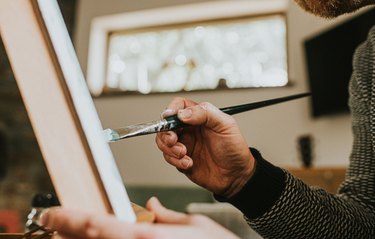
If you have ever watched the late Bob Ross in the Joy of Painting TV show, then you are familiar with the term "liquid white." Before Bob begins his masterful paintings, he always lets the viewer know that the canvas on his easel already has a nice thick layer of liquid white on it. After Bob Ross uses the liquid white, he begins painting his heart out, all while gleefully "beating the devil" out of his brushes and sharing stories about his little forest friends in the landscape painting.
The function of liquid white in Bob Ross painting
Video of the Day
Liquid white is essential to the "wet-on-wet" painting technique. You coat the canvas with a base coat of the liquid white, sometimes called liquid clear, and then paint over that. Whereas oil paints are thick and have a consistency of soft butter, liquid white is more of a creamy paint. The creaminess of the liquid white allows it to be painted on the canvas in even and smooth strokes.
Video of the Day
Keep in mind that oil paints are slow drying. When you use the Bob Ross technique of wet-on-wet painting, remember that applying a thick layer of liquid white can increase the drying time of your painting.
Comparing liquid white and gesso
Some people may get confused between liquid white and white gesso. They are not the same thing. Liquid white is only used with wet-on-wet painting. Bob Ross's liquid white is a secret combination of ingredients exclusive to Bob Ross Inc.
Liquid white is only usable with wet technique and oil painting, not with other painting techniques like water color. Other variations of the base coat medium are available, like liquid clear, liquid black and liquid opal.
White gesso is a primer that also gets painted on the canvas before painting, but it is meant to be used with acrylic paints and must be dry first before beginning your painting. Gesso is used to add texture to the painting and to prevent the paints from being too absorbed into the cloth canvas.
Make your own liquid white
Depending on where you live, finding some painting supplies like liquid white can prove to be difficult. You can likely buy art supplies, including Bob Ross oil paints and liquid white online from Bob Ross, Inc. or on Amazon. However, it can be quite expensive.
One way to help solve that problem is to make your own liquid white. Add some linseed oil to titanium white oil paint and mix it together until you get a slick, smooth paint. It should be thick, with a consistency similar to sour cream.
Then, coat your canvas and you're ready to paint. When using this home-made variation of liquid white, you will have to thin your other paints down with a little linseed oil as well for the best results before using a painting knife or paint brush to apply them to the canvas.
Benefits of liquid white in oil painting
It may seem like an unnecessary extra step to beginners, but a base coat of liquid white on the canvas lightens the pigments of the paints as they are applied to the canvas. This is especially important when painting a multi-hued scene, like a natural-looking sky.
For example, in the upper corners of the canvas, you can apply a more liberal amount of paint and then drag the color to the inside of the canvas, allowing it to fade as you go. The liquid white softens and mutes the color for a more realistic look.
The liquid white enables more layers to be visible in your painting. Because the first color being applied on top of the liquid white will be slightly lighter, additional layers will add depth to your scene. You can use any oil colors you want on liquid white including cadmium yellow, alizarin crimson, Prussian blue and sap green.
How to use gesso with acrylic paint
If you prefer working with acrylics, and you want to try a wet-on-wet approach to your painting, try the following: wet the canvas with a little bit of water. Paint a thin coating of gesso (in whatever color you wish) over the canvas.
Spray a drying retardant over the gesso and start painting. Gesso has a faster drying time liquid white does in oil painting, but if you find the painting drying too fast, just spray more drying retardant on the canvas and continue.